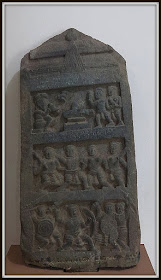THE HERO STONES
The first of the many posts I intend to write on the exhibits in the Goa State Museum, as the name suggests, is on the Hero Stones which are common in this part of the country. These are carved stone slabs that commemorate the death of those brave men who laid down their lives on the battlefield fighting to either protect or uphold the honor of their kingdom or its people from adversaries. Alternatively known as Virgal, they are generally divided into three panels, though in rare instances as many as five panels are seen. Of these, the lowest shows the hero decked up in full military armour, vanquishing the opponents before falling on the ground himself. In the middle panel, he is shown being lifted towards the heavens, accompanied by nymphs and other mythical figures celebrating his ascent whereas the topmost panel shows him seated in the Swarga Lok (Heaven) worshiping the Gods, a fitting tribute to a person who had perished for the 'larger cause'. Besides, accompanying inscriptions, either in Devnagari or Kannada give the name of the hero, sometimes the year of his death and the battle in which he met his ultimate end.
Goa being an important trading centre along the western coast was always the bone of contention amongst the various dynasties vying for power in northern and central Deccan. As such, battles were frequently fought for the control of the rich port and these would have resulted in casualties running into hundreds and thousands, each time the opposing armies met on the battle field. The valor displayed by some of these brave men was 'immortalized' in this unique form. Perhaps, this is the most probable explanation for the large number of hero stones to be found in this region.
Hero Stones or Virgal - 12th century AD
There are two Hero Stones in the State Museum, both of these dating back to the 12th century AD which corresponds to the time when Goa was ruled by the Kadambas from their base at Chandrapur (modern Candor). The one on the left made of Compact Chlorite Schist was found at Khandepar in Ponda taluka whereas the one on right was found at Malkarne in Sanguem taluka and is made of Talc Chlorite Schist stone.
The one one the left is particularly interesting. The lowest panel of this memorial shows the hero being slayed by a person with a sword. However, the interesting bit about this panel is that there is a person on the extreme left who is playing a musical instrument as the hero is being killed as if it was some kind of a ritual and not a regular battle scene. Could this be the depiction of an instance of human sacrifice, perhaps the stone was commissioned to recount the bravery of a villager who volunteered to be killed for the betterment of entire society as a whole; if yes, what was the reason for this gory ritual and whom are the contemporary people who inhabited Khandepar aiming to please by this act. The middle section show the celebrations in the honour of the hero whereas the topmost panel depicts him merging into a Shiv Linga and being worshipped by a priest and an attendant.
Reference: Catalogue of the Remarkable Sculptures in the Goa State Museum


No comments:
Post a Comment
Leave your comments/suggestions/views here